Against even the worst of possibilities, must be set the inescapable obligation of Christians, that the Body of Christ must be prepared to offer itself up for the sake of the healing and the solidarity of the whole human family, whatever its religious or racial identities. Especially must the Body of Christ risk its own life in bearing and sharing the burdens of those who are being exploited, humiliated, and disinherited!"
" John Hines
His Call to Social Action
Born October 3, 1910, John Hines grew up in the rural South Carolina community of Seneca where he attended a small Episcopal church. After completing his studies at the the University of the South, Hines graduated from the Virginia Theological Seminary, starting his ordained ministry during the Great Depression in 1933. Hines was called first to serve in St. Louis, Missouri, under the direction of Bishop Will Scarlett, a prominent advocate of the "Social Gospel," which emphasized the active application of Christian principles to solving society's problems. There he met and married Helen Orwig with whom he would raise four sons and a daughter.
Called to serve a large parish in Augusta, Georgia in 1937, Hines continued to disseminate the message of Christian social action learned under Bishop Scarlett. While in the deep South, he was a courageous preacher against the sin of discrimination and defended all those lacking sufficient educational, economic, political, and social resources. In Houston, Texas, Hines served as rector of Christ Church throughout World War II from 1941 to 1945. At the young age of 34, he was elected bishop coadjutor of the Diocese of Texas, a position he held for a decade. Hines' ecclesiastical building achievements proved to be unparalleled, establishing a seminary, a secondary school, a nursing home, and 41 new congregations during his term.
He continued his social activism and worked to end racial segregation and to increase the presence of active African American clergy and laity in the Church. After his consecration as bishop of Texas in 1955, he worked to integrate all the institutions and agencies of his diocese and urged advocacy for civil rights among Episcopalians.
Driven to Empower
Hines' drive, commitment, and rare character were recognized by the House of Bishops in 1965 when they elected him as Presiding Bishop, a position he held until 1974. At a time of extreme turbulence within the country and the Episcopal Church, Hines guided the Church labeling himself a, "theological conservative and social progressive." Taking an activist approach to social issues, Hines supported greater minority involvement in church councils and the ordination of women.
Above all, Hines positioned himself on the battlefront where Christian values converged with racism and poverty. This was profoundly evident in his response to the riots that broke out in dozens of American inner cities in 1967. Hines boldly proposed a reordering of the Church's financial priorities in order to help address the deep inequalities in American society.
He proposed empowerment and self-determination for African Americans by advocating for political and economic independence based on financial help free of conditions.
His vision resulted in the General Convention Special Program. Initially accepted by church members, it later became a source of dissension causing many congregations to withhold funds from the General Convention. In his aim to rid the Church of overt racism, Hines' GCSP accomplished much in spite of the backlash and misgivings of the Episcopalian majority.
Hines demonstrated innovation once again when in 1971 at a General Motors shareholders' meeting, he supported the movement to divest American corporations of interests in South Africa as a way of protesting the systematic racism of apartheid. The divestment movement was credited by former Archbishop Desmond Tutu of South Africa as fundamental in the eventual collapse of apartheid. In 1971 Hines was named "Clergyman of the Year" by the interfaith organization Religious Heritage of America.
The Consequences of Controversy
In spite of the controversy and criticism targeting Hines and affecting his decision for voluntary retirement before the end of his term, he did not abandon his commitment to the impoverished and oppressed. Debate detracts from the legacy of Hines' term as Presiding Bishop. Although he forever changed the Church's definition of domestic mission to social engagement, he is also considered the chief cause of the church's shrinking population and loss of confidence in national structure. The personal toll was also profound.
Upon his retirement in 1974, he and his wife moved to North Carolina where they lived for almost 20 years. Rarely did he participate in national church affairs, preaching infrequently, lecturing occasionally, and participating in the consecration of bishops. In 1993 he and his wife, Helen, moved to Austin, Texas. Helen died in 1996, and he succeeded her in 1997.
His personal papers are located at The Archives of the Episcopal Church.
"Excerpts from "The Most Reverend John Hines", 1910-1997 The Archives of the Episcopal Church
Born: October 03, 1910
Died: July 19, 1997




















